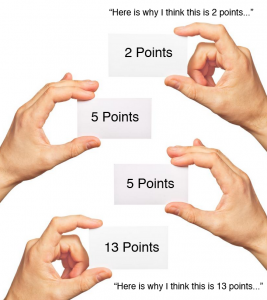Agilists are faced with challenges related to a company culture on a daily basis. We are instruments of change, and we are influencers to those who are willing to contribute to business agility and reduce VUCA.
A question was asked yesterday in the Agile Alliance Coaching Network that was very intriguing: Is culture an emergent property of the complex system of humans? And if so… can culture be designed or created with intent?
Yeah, that’s a lot to take in! It might help if we break the question into two segments: culture being an emergent property, and creating a culture with intent. Below are some of the thoughts of the group with some of my thoughts.

Is (company) culture an emergent property?
I, and others in the coaching network, believe that people contribute to the agility of a company, especially if you agree that a culture is in fact constructed from a complex system of humans. We are not “resources”, however, as humans we are resourceful when taking on challenges in our daily lives (this is a subtle but important difference in the terms). Meeting those challenges requires us to take on certain behaviors. Over time, these behaviors form habits as we learn more about how a system, process or any other complexity works and how those challenges are met.
Take the example of a new corporation. When a new corporation is formed it has no defined culture. Now introduce business needs. A new corporation, which is formed by a complex system of humans, will use every bit of their resourcefulness to meet those business challenges and deliver a solution to satisfy the need. The corporation will know if the need is satisfied based on feedback. This feedback allows us to improve our practices and principles to deliver the solution quicker with better quality to obtain the highest value. So we exhibit certain behaviors which, over time, create habits. It’s these behaviors and habits which become more prominent, so in effect, a culture is an emergent property of the complex system of humans.
The group agreed on this conclusion that a culture is emergent. Not only that, it can be unpredictable, and it’s up to those who are willing to reduce that uncertainty to choose to change the culture. This ability to recognize that change is a choice leads into the second part of the question.
Can culture be designed or created with intent?
Let’s immediately address the created side of the question. When your intention is to find the most efficient ways to meet the challenges of the business, and if you agree that a culture is an emergent property, then yes, culture can be created with intent.
So can it be designed? The word “design” in itself almost suggests intent. There is some ultimate, or designed, goal that needs to be reached. Moreover it suggests that a certain culture already exists. Getting from one culture to another requires a certain amount of change. The complex system of humans, therefore, need to change habits and behaviors in order to achieve a designed culture. Agile cultures are ones that have the resilience to reduce the VUCA by creating self-autonomous teams of experimentation and empiricism.
So we did agree that a culture can be designed with intent, however, it’s not easy to do. Here are some techniques we discussed to contribute to a designed emergent culture.
- Make the design transparent. A designed culture can be as simple as a mission statement, or a list of values or principles. Display these in key locations, and continue to “drill” these principles into the culture. Always ask questions for clarification.
- Observe leadership behaviors. The behavior of leaders in an organization is the model for a culture. Decisions that leaders make should line up with values and principles. Commitments met need to be recognized and celebrated, however, leaders that say they will behave one way and end up behaving another need further exploration, especially if the behaviors do not line up with company values.
- Isolate a part of the organization where you can experiment. A point that was raised in the group was that feedback influences the behaviors of an organization. Self-organizing teams that have the safety to experiment can use feedback to influence their behaviors to deliver the next iteration. Use the feedback from this group to scale your efforts and experimental behaviors.
- Continuously question control or governance structures. As an agile coach a often hear the statement “we have always done it this way”, and it generates several questions in my head. Being aware of these control structures is the first step to choosing to change them. However, one must recognize some control structures are more difficult to change than others, which becomes a question of empowerment. To further enhance this point, try to separate the flow of work from the flow of supervision to promote self-organization.
- Embrace HR as part of an agile culture. For those who don’t know, the “H” does stand for human, which is how a culture emerges. Also, we are people and not resources. Perhaps simplifying the review structure to be 3 measures: what you accomplished, what you did to improve the team, and who did you mentor to create more of you. HR can also be a big influencer of a learning culture by promoting continuous training of individuals and leaders, and to continuously promote the intended designed culture.


